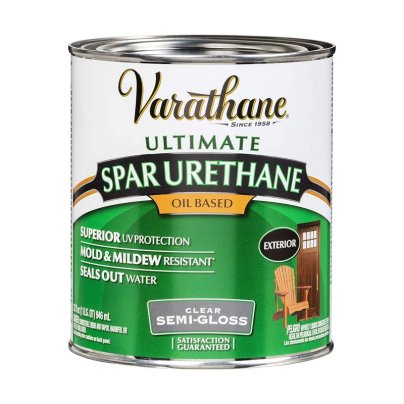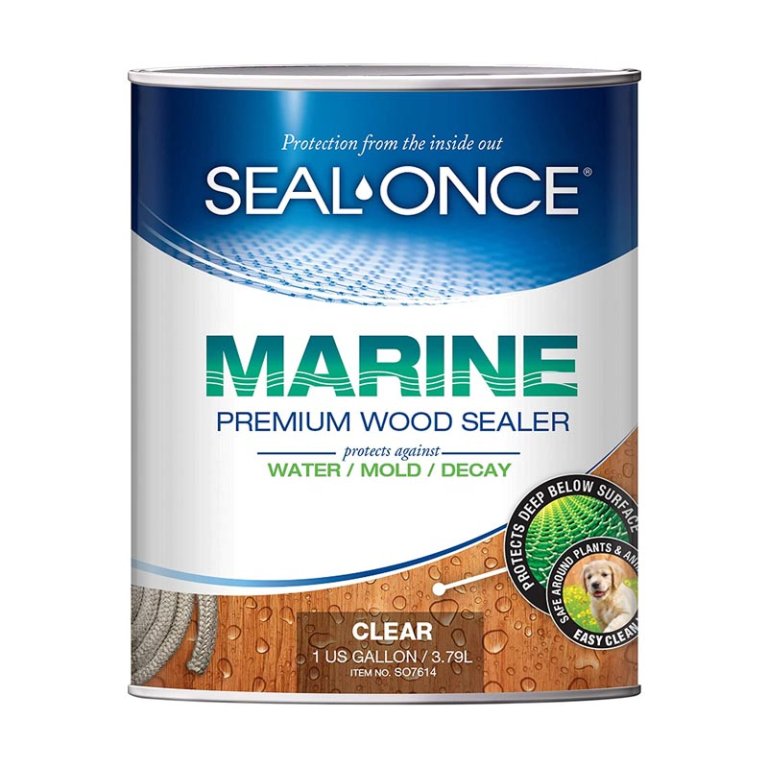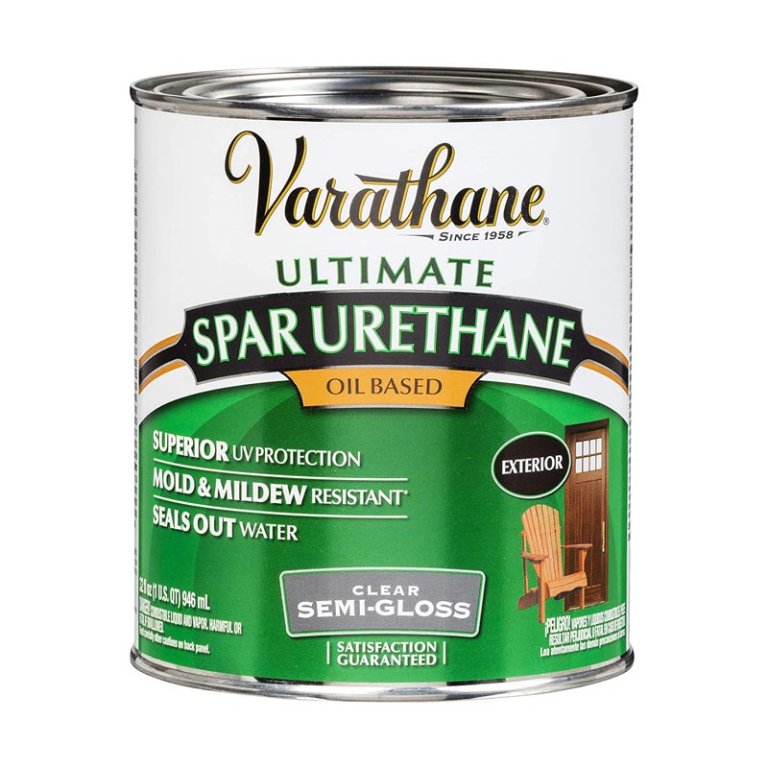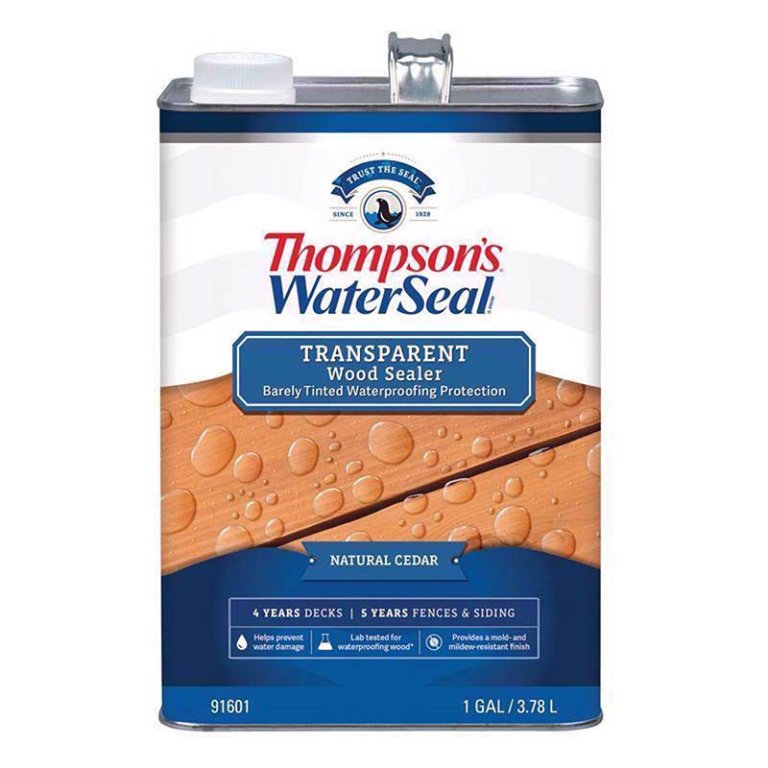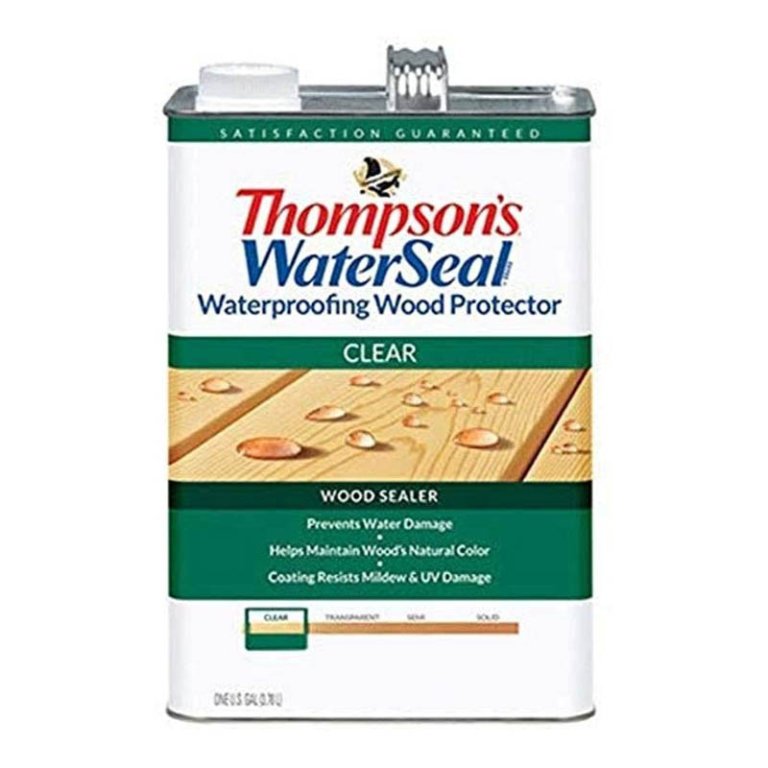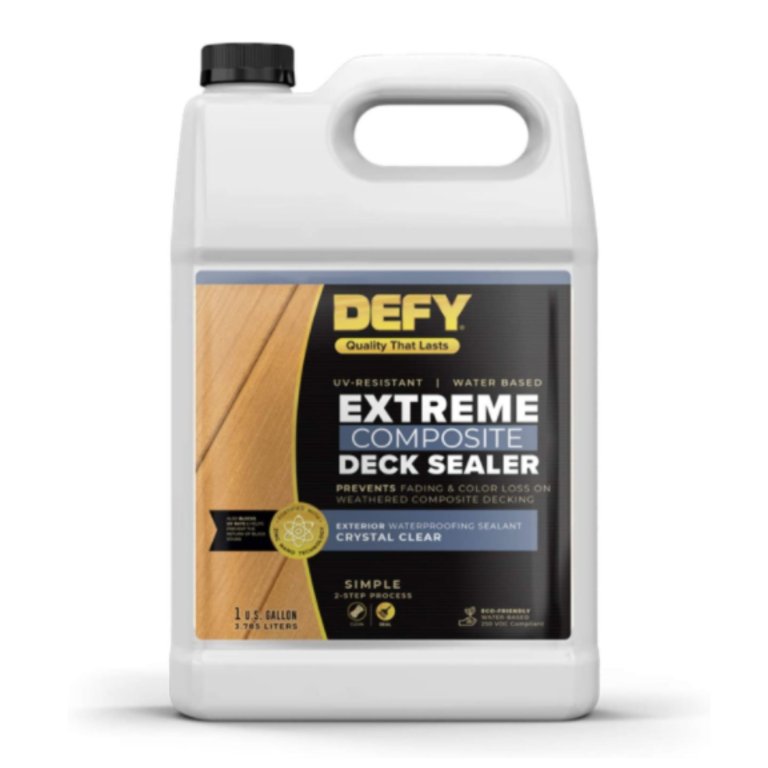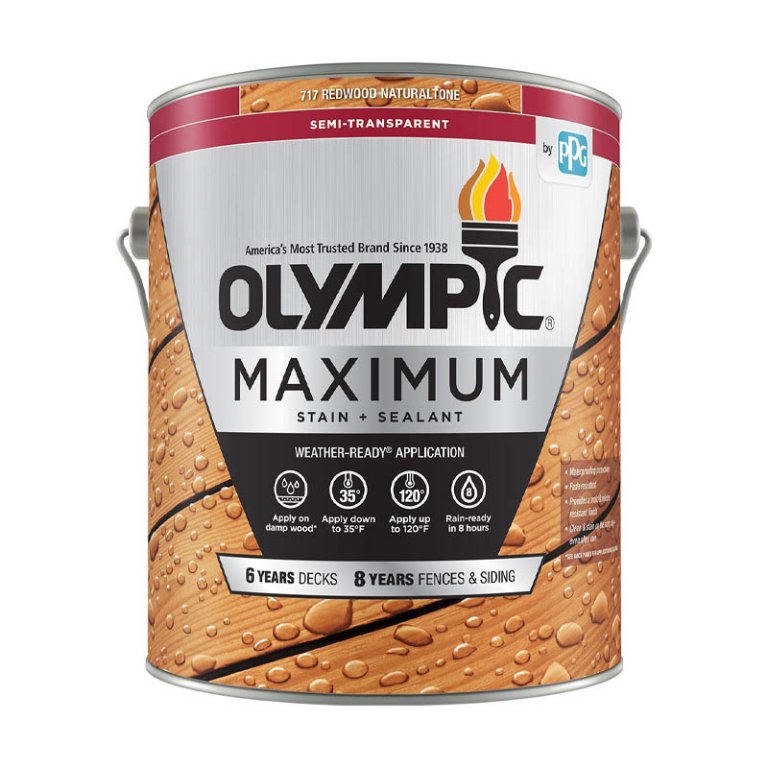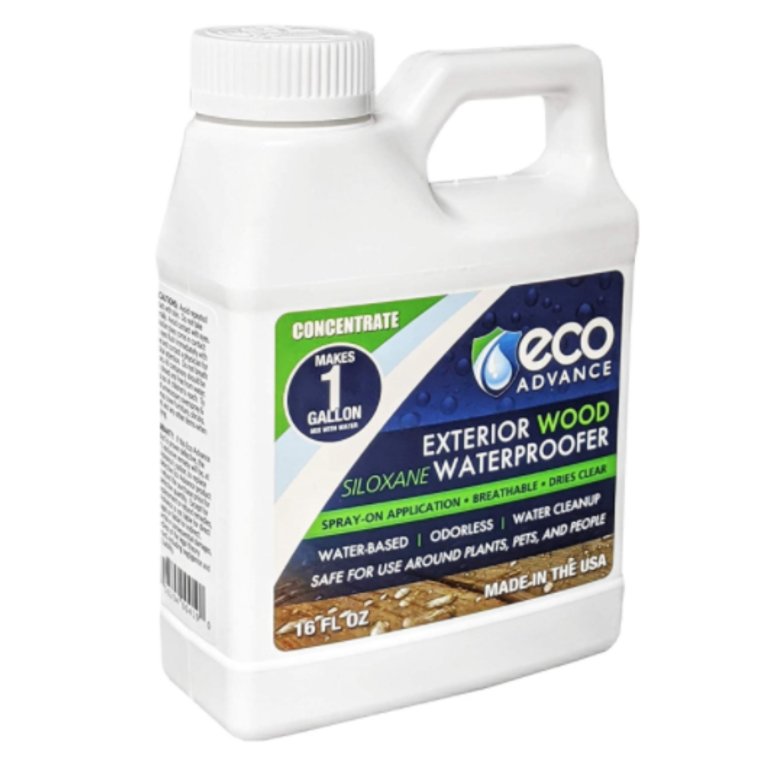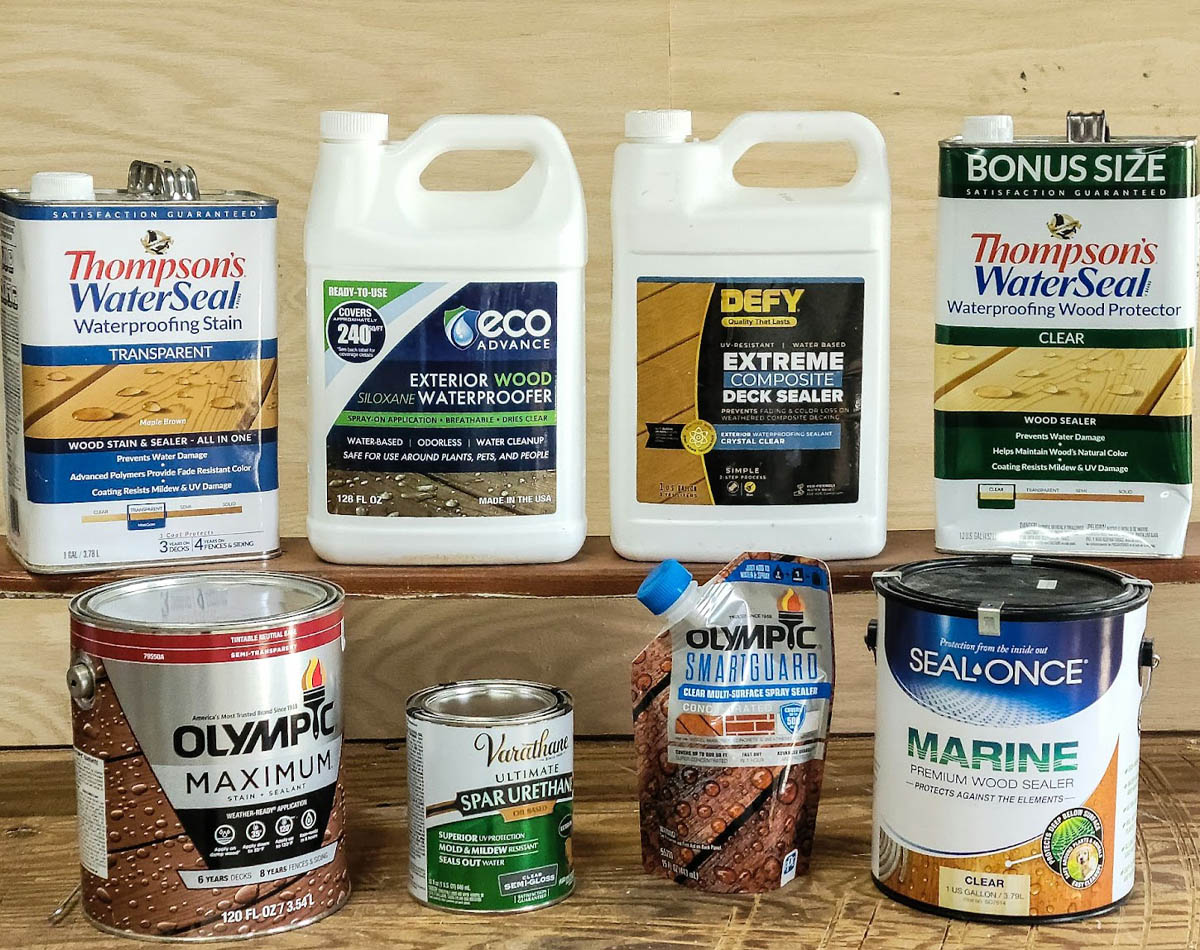
We may earn revenue from the products available on this page and participate in affiliate programs. Learn More ›
For lots of folks, the deck is a place to make memories: relaxing, socializing, just enjoying life. But the elements (sun, rain, snow, and wind), as well as people partying on the surface, take their toll, wearing away at the wood and leading to cracks, splinters, fading, and rot. We knew that using a high-quality deck sealer could reduce such damage, so we wanted to find out which of today’s deck sealers were really worth buying and relying on. Our top pick was the Seal-Once premium wood sealer, with its deep penetrating and low VOC formula.
We decided to test the most popular brands available. Our tests involved applying the sealers to decking boards, noting how easy they were to use, whether they repelled water, and how they stood up to the weather and normal wear and tear, such as foot traffic and ground-in sand.
The best deck sealer will protect the deck from damage while still allowing the natural beauty of the wood grain to show through. A clear deck sealer won’t reveal an uneven application, brushstrokes, or runs, unlike colored stain or solid paint, and sealing a deck successfully is a relatively easy task for the average DIYer.
Read on to learn more about choosing the best deck sealer for your outdoor living space, weather conditions, and budget—and discover how the following products earned a spot in this lineup.
- BEST OVERALL: Seal-Once Marine Premium Wood Sealer
- BEST BANG FOR THE BUCK: Rust-Oleum Varathane Spar Urethane Deck Sealer
- PRESSURE-TREATED WOOD PICK: Thompson’s WaterSeal Transparent Wood Sealer
- BEST FOR WATERPROOFING: Thompson’s WaterSeal Clear Wood Sealer
- BEST WITH UV PROTECTION: Defy Composite Deck Sealer
- BEST LONGEVITY: Olympic Maximum Oil-Based Clear Waterproofing Sealant
- EASIEST TO USE: Eco Advance Exterior Wood Water Repellent Concentrate
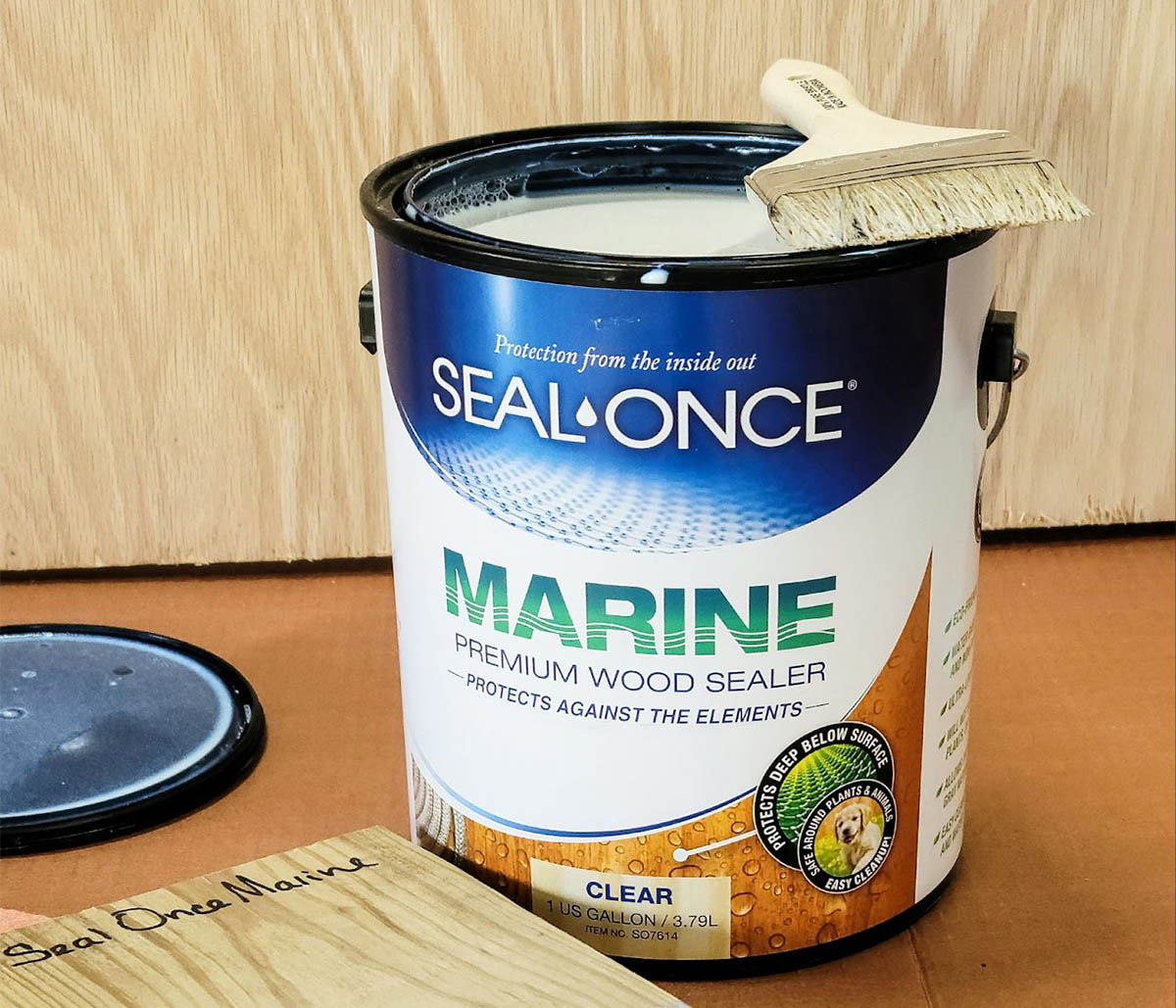
| Type | Weather Resistance | Coats Required | |
| Seal-Once Marine Premium Wood Sealer | Water-based | UV and moisture resistant | 2 |
| Rust-Oleum Varathane Spar Urethane Deck Sealer | Oil-based | Water and UV resistant | 2 to 3 |
| Thompson’s WaterSeal Transparent Wood Sealer | Water-based | Moisture and UV-protected | 1 (2 for deeper color) |
| Thompson’s WaterSeal Clear Wood Sealer | Water-based | UV and moisture resistant | 1 to 2 |
| Defy Composite Deck Sealer | Water-based | Water and UV resistant | 2 |
| Olympic Maximum Oil-Based Clear Waterproofing Sealant | Water-based | UV and moisture resistant | 2 |
| Eco Advance Exterior Wood Water Repellent Concentrate | Water-based | Moisture-resistant | 2 |
Our Top Picks
The best deck sealer should meet a user’s needs for appearance, budget, application, and drying time in addition to protecting the deck. We applied each of the following deck sealers to decking boards, noting how long it took them to dry, whether they needed a second coat, and how well they stood up to water, weather, and wear. The following deck sealers are among some of the industry leaders for maintaining wood decks, well-suited to various deck specifics. Learn the pros and cons of each product, and find out how they earned a spot on this lineup.
Best Overall
Seal-Once Marine Premium Wood Sealer
What We Like
- Deeply penetrating formula; does not allow any water to penetrate after dry
- Applies clear; does not alter the color or finish of the wood
- Low VOCs; ideal for those that prefer eco-friendly or low-chemical products
- Resists salt, mold, and algae; perfect for those that live in the outdoors or near water
What We Don’t Like
- Some users have reported thin application texture; may require many coats
Product Specs
- Type: Water-based
- Weather resistance: UV and moisture resistant
- Coats required: 2
Our Ratings: Application 4/5; Appearance 5/5; Durability 5/5; Value 5/5
When we opened the can of Seal-Once Marine Premium Wood Sealer, the first thing we noticed was that something was missing. The smell! Sealers are notorious for emitting toxic odors, but this low-VOC sealer had virtually no smell at all.
We started testing by applying a thin layer of sealer to a decking board with a brush. Though it looked slightly milky, it became clear as it began to dry. In 45 minutes, when the surface was still somewhat damp (as recommended), we applied a second coat. After that, we set the board aside and let it dry 24 hours before continuing our tests.
When completely dry, we tested for water resistance by spraying the board with a hose. On the untreated section of the board, the water soaked in. On the section treated with Seal-Once, the water beaded up and ran off.
We then placed the board flat on the ground and sprinkled sand on it, after which we walked over it numerous times to mimic foot traffic on a real deck. After sweeping the sand off, we inspected the surface for scratches. We found minor scratches on both the treated and untreated sections of the board, but the scratches were shallower on the sealed area.
Finally, we left the board outdoors for a month of harsh sun rays, wind, rain, and even freezing nighttime temps. After which, we scrubbed the board clean with a nylon-bristle brush and an all-purpose household cleaner and let it dry. We then tested once more for water resistance, and the water again beaded up on the sealed section of the board. While we don’t know how this sealer would survive a harsh winter or a couple of summers, it held up well in our 1-month testing window.
Get Seal-Once deck sealer at Amazon or Walmart.
Best Bang for the Buck
Rust-Oleum Varathane Spar Urethane Deck Sealer
What We Like
- Semigloss finish provides a sleek look to outdated wood or decking
- Protects against mold and mildew; ideal for those that live in moist environments
- Scratch resistant finish keeps the deck looking fresh in the long-term
- Lasts for up to 5 years; little to no maintenance required after first applied
What We Don’t Like
- Requires a minimum of 3 coats to keep wood surfaces protected
- Strong fumes may be emitted during the application process
Product Specs
- Type: Oil-based
- Weather resistance: Water and UV resistant
- Coats required: 2 to 3
Our Ratings: Application 3.5/5; Appearance 5/5; Durability 5/5; Value 5/5
Protecting the backyard deck doesn’t have to cost a fortune. Rust-Oleum’s Varathane Ultimate sealer adds a layer of defense against the elements while giving a deck an attractive semigloss sheen. (Spar is a term traditionally used to designate high-quality varnish used on boats.)
We brushed on a light coat of this spar urethane, and it went on smoothly and uniformly. It has strong fumes, so we opened a window and turned on a fan while working with the product. This sealer takes slightly longer to dry than some of the others we tested, and the manufacturer suggests a minimum of three coats, so we applied the subsequent coats 4 hours apart. We then waited a recommended 3 days after the final application before starting our tests.
When we sprayed the board with a hose, the water on the sealed section of the board beaded up and ran off. We sprinkled sand over the surface and walked back and forth on the board; after brushing the sand off, we saw scratches on the non-sealed section but none on the area we’d sealed with the spar urethane.
After a month in the sun, wind, and rain, we scrubbed the board with a brush and all-purpose cleaner, let it dry, and retested it for water resistance. The water beaded up once again. The unsealed section of the board had weathered some, but the part sealed with Varathane’s spar sealer was still bright and new looking.
Get Rust-Oleum Varathane deck sealer at Amazon, The Home Depot, or Walmart.
Pressure-Treated Wood Pick
Thompson’s WaterSeal Transparent Wood Sealer
What We Like
- Adds a small amount of color to wood for those that want a deck refresh
- Fade-resistant formula keeps wood and decking looking fresh for years
- Requires just 1 coat for full protection; requires a lot less work than comparable options
What We Don’t Like
- Thin consistency may lead to messy application
Product Specs
- Type: Water-based
- Weather resistance: Moisture and UV-protected
- Coats required: 1 (2 for deeper color)
Our Ratings: Application 4/5; Appearance 5/5; Durability 5/5; Value 4.5/5
Treated wood—such as white pine or fir that’s been saturated with chemicals designed to limit weathering—can take on an unappealing greenish tint. Applying a sealer that has a bit of color can counteract the greenish hue while protecting the deck.
We tested Thompson’s WaterSeal Transparent Waterproofing Stain in maple brown, and it imparted a hint of color—not enough to change the look of the wood grain but just enough to enhance it. (Since we tested this product, Thompson’s has updated the look of the bottle and the name of the product and stain, though the formula is the same. It’s now known as Thompson’s WaterSeal Transparent Wood Sealer in Desert Tan.) The sealer is thin and watery, so it’s kind of messy to apply with a brush. It would probably be more suitable for an airless spray rig, but we didn’t have one available. This product had some fumes, but we found it tolerable.
The sealer started to soak in right away, and the manufacturer recommends just one or two coats, the second coat if a deeper color is desired. We gave the board two coats and then let it dry for 24 hours before continuing our tests. When sprayed with the hose, water beaded up on the sealed section of the board but soaked into the bare, untreated section. Although the color was slightly different where we applied Thompson’s WaterSeal, no other difference was visible—no surface sheen was apparent, and the wood grain was still prominent.
After sprinkling on the sand and walking on it, we did notice scratches on the sealed section, but the scratches did not reveal fresh (unstained) wood beneath. This suggested to us that the sealer had penetrated deeper than just the surface of the wood.
Once a month in the sun and elements had gone by, we gave the board a good scrubbing. Thompson’s WaterSeal Transparent sealer continued to protect the wood from moisture, as the water beaded up and ran off.
Get Thompson’s transparent deck sealer at Ace Hardware or Lowe’s.
Best for Waterproofing
Thompson’s WaterSeal Clear Wood Sealer
What We Like
- Applies clear; does not alter the current look or finish of the wood or decking
- Protects against mold and mildew; suitable for those that live near water or in moist environments
- Scratch-resistant finish keeps the deck looking fresh for years
What We Don’t Like
- Thin and runny formula may be messy to apply
- Slight odor but tolerable; some users may want to wear a mask while applying
Product Specs
- Type: Water-based
- Weather resistance: UV and moisture resistant
- Coats required: 1 to 2
Our Ratings: Application 3.5/5; Appearance 5/5; Durability 5/5; Value 4.5/5
Thompson’s WaterSeal Clear Wood Sealer’s penetrating protection will provide a robust defense against the elements without changing the wood’s natural color or adding a sheen. This makes it well suited to exterior woods with desirable coloring such as cedar and redwood.
As the second Thompson’s WaterSeal product we tested, this sealer was also thin and runny. However, unlike the Thompson’s stain/sealer combo, this formula created a clear but visible layer on the surface of the decking board. We applied a second coat (although the manufacturer claims that one is often sufficient) and then waited the recommended 48 hours for the sealer to cure before continuing the tests.
This clear Thompson’s WaterSeal repelled water as well as the transparent product, and it seemed to withstand scratches even better. We couldn’t find any scratches on the sealed section of this test board, so we set it out to weather the elements for a month. Once the month was up and the board was scrubbed and dried, the clear sealer repelled water just as well as before, and the wood beneath the sealed section still looked fresh and new while the untreated area had weathered some.
This sealer also purports to protect wood from mold and mildew, making it optimal for rainy areas, but we were unable to test that feature. However, this product provided a protective layer and preserved the color of the wood, so we feel it would be a beneficial treatment to keep wood decks looking good.
Get Thompson’s clear deck sealer at Amazon, Ace Hardware, Lowe’s, Blain’s Farm & Fleet, or Walmart.
Best with UV Protection
Defy Composite Deck Sealer
What We Like
- Zinc particles offer UV protection; ideal for decks that get ample sun exposure
- Versatile formula; compatible with wood and composite surfaces
- Includes high-quality resins for long-term durability
What We Don’t Like
- Doesn’t offer much protection from scratches; may not be ideal for those with pets or frequent parties
Product Specs
- Type: Water-based
- Weather resistance: Water and UV resistant
- Coats required: 2
Our Ratings: Application 5/5; Appearance 5/5; Durability 4/5; Value 4.5/5
According to the manufacturer, the addition of tiny zinc particles in Defy Composite Deck Sealer gives it superior protection from harmful UV rays. This formula is suitable for wood and composite decks to keep them from fading or graying. This premium-grade deck sealer contains quality resins that protect decks while adding a soft transparent sheen.
We brushed Defy on a wood decking board, and it went on smoothly and evenly (a pump sprayer can be used instead, if desired). The result was a transparent layer that penetrated the surface without altering the appearance of the wood grain. There was a slight paint-type smell but nothing too disagreeable. We applied a second coat after 2 hours, per the instructions, and then let the sealer cure for 24 hours before further testing.
As with the other sealers tested, water beaded up on the surface of the board treated with Defy. The sealer offered some protection against scratches from sand but not as much as some of the other tested products. Defy might be better suited to a deck that doesn’t get a lot of foot traffic from kids and pets.
After a month in the elements and scrubbing with an all-purpose cleaner, the section of board sealed with Defy still looked new and fresh, and it continued to repel water well. While we didn’t test Defy on composite decking, we feel it would perform just as well as it did in our wood decking tests.
Get Defy deck sealer at Amazon or Walmart.
Best Longevity
Olympic Maximum Oil-Based Clear Waterproofing Sealant
What We Like
- Protects up to 6 years; requires little to no maintenance after the first application
- Versatile formula; can be applied in cold temperatures
- Protects against mold and mildew; suitable for those that live in moist environments
What We Don’t Like
- Not scratch resistant; may not be ideal for those that have pets or use their decks very frequently
Product Specs
- Type: Water-based
- Weather resistance: UV and moisture resistant
- Coats required: 2
Our Ratings: Application 5/5; Appearance 5/5; Durability 4.8/5; Value 5/5
Some deck sealers suggest reapplying the product as often as every year to maintain water resistance, but Olympic Stain MAXIMUM Stain + Sealant protects decks up to 6 years, making it well suited for long-term protection. It’s also suitable for applying in temps as chilly as 35 degrees Fahrenheit, which makes it more versatile. Many other sealers require application when the outdoor temperature is over 55.
The sealer went on without any noticeable odor, and we applied two thin coats, the second 2 hours after the first. Then, we set the board aside for 24 hours to completely cure. The Olympic Stain + Sealant combo left a thin film on the board’s surface that imparted a slightly wet look even when dry. It repelled water, and while it suffered a few scratches from sand, they were minimal. After a month in the elements and cleaning with a brush and all-purpose cleaner, water still beaded up and ran off the treated section, and the wood beneath the sealer still looked new.
Get Olympic Maximum deck sealer at Amazon, The Home Depot, or Tractor Supply Co.
Easiest to Use
Eco Advance Exterior Wood Water Repellent Concentrate
What We Like
- Dries clear; will not alter the color or finish of the wood or decking
- Eco-friendly formula; safe for use around plants and people
- Odorless and nontoxic; safe to be around during the application and drying process
- Protects against mold, oil, and pool chemicals
What We Don’t Like
- Doesn’t offer much scratch protection
Product Specs
- Type: Water-based
- Weather resistance: Moisture-resistant
- Coats required: 2
Our Ratings: Application 5/5; Appearance 5/5; Durability 4/5; Value 4/5
Brushing on deck sealer can be backbreaking work, but Eco Advance Wood Water Repellent can help folks get the job done with less trouble. Simply pour it into a garden or deck sprayer and apply a light coat to cover the entire deck with ease. Of course, for our test board, we simply brushed the sealer on, which is also acceptable. If we were treating a large area, it would sure be handy to use a sprayer.
This deck sealer goes on crystal clear and leaves a very thin film on the surface. We applied a second coat 30 minutes after the first coat (as recommended) and then let the sealer cure for a full 24 hours. Water beaded up and ran off as expected, but Eco Advance didn’t do too much to protect the wood from sand scratches. We found just as many in the treated section as in the untreated section.
This water-based formula won’t harm the surrounding lawn or outdoor plants. It’s odorless, low in VOCs, and nontoxic to people and pets. We didn’t detect even a slight odor during application. It stood up well after a month in the elements and a good scrubbing. It still shed water, and the wood beneath looked new and fresh, although the surface film that was so noticeable before seemed to have faded some.
Get the Eco Advance deck sealer at Amazon, The Home Depot, or Lowe’s.
Jump to Our Top Picks
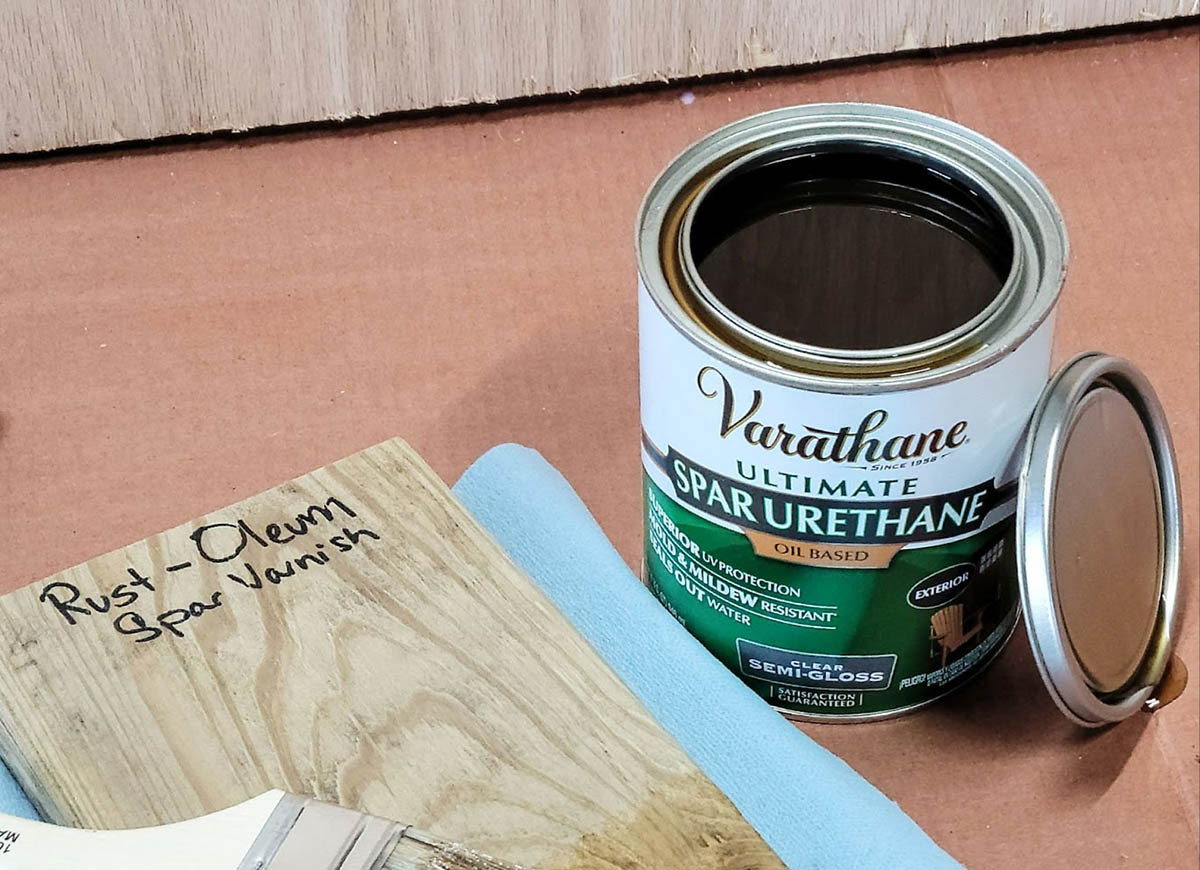
Before Buying Deck Sealer
Before choosing a deck sealer, be sure that it’s the correct product for your needs. Sealer, stain, and paint can all protect your deck from the elements, though each one has different features. According to Rafi Friedman, president of Coastal Luxury Outdoors in Jacksonville, Florida, “Deck sealer is much more important in humid conditions, and in areas with large temperature swings, especially if you get frequent freezing where you live.” He added that “if your deck is made of a fade-resistant material, I’m a fan of water-based sealers, since they last longer under all conditions.”
Paint is typically a better choice on worn decks with mismatched boards or stains that won’t come off. It covers up these issues while offering an attractive uniform finish. While a clear sealer will prolong the useful life of an older, weathered deck, it won’t update the deck’s look.
Stain, like paint, changes the color of the wood. However, instead of forming a topcoat, stain penetrates the wood fibers in the same way as sealer. Stain is beneficial for evening out splotchy color while maintaining the beauty of natural wood grain.
Deck stain imparts a natural-looking wood color, but depending on the opacity, it can provide just a hint of color or completely obscure the wood grain, as paint would do. In addition, some deck sealers include a slight tint of color, and these stain-and-sealer combos are helpful for both protecting and refreshing the look of the wood.
If you’ve decided that stain is the right choice for you, Friedman shared more of his expert knowledge: “When you apply deck sealer, you’re sealing in anything that was in or on your deck. If you seal in moisture, your deck can continue to rot despite the sealer.” He went on to say that “this is why it’s essential to thoroughly clean and sand your deck and wait for clear, dry conditions before applying sealer.”
How We Tested the Best Deck Sealers
| Testing Stats | |
| Products tested | 8 |
| Time spent testing | 1 hour per sealer, over several days |
| Tests performed | 9 to 10 |
| Price range | $10 to $70 |
Testing deck sealers was relatively straightforward. We brushed (or otherwise applied) two coats of each sealer on a decking board and then tested it for water resistance and scratch resistance. However, the real measure of a deck sealer is the test of time. We would have liked to test the sealers over a few years, but we had only a month to see how well they held up to the elements.
We positioned each test board outdoors to receive UV rays in a spot where it would be subject to the elements for a month. The temperature dipped below freezing at least 11 nights during the test phase. At the end of the month, we inspected each board for any signs of peeling and we tested again for water resistance.
In addition to noting how well the sealers held up, we also noted how easy they were to apply and how uniformly they covered the boards. For each test, we used a rubric to record points—the better a sealer performed in any area, the more points it received. At the end of the tests, we added the points and used them to help determine the best category for each product.
| Application | Appearance | Durability | Value | |
| Seal-Once Marine Premium Wood Sealer | 4/5 | 5/5 | 5/5 | 5/5 |
| Rust-Oleum Varathane Spar Urethane Deck Sealer | 3.5/5 | 5/5 | 5/5 | 5/5 |
| Thompson’s WaterSeal Transparent Wood Sealer | 4/5 | 5/5 | 5/5 | 4.5/5 |
| Thompson’s WaterSeal Clear Wood Sealer | 3.5/5 | 5/5 | 5/5 | 4.5/5 |
| Defy Composite Deck Sealer | 5/5 | 5/5 | 4/5 | 4.5/5 |
| Olympic Maximum Oil-Based Clear Waterproofing Sealant | 5/5 | 5/5 | 4.8/5 | 5/5 |
| Eco Advance Exterior Wood Water Repellent Concentrate | 5/5 | 5/5 | 4/5 | 4/5 |
What to Consider When Choosing a Deck Sealer
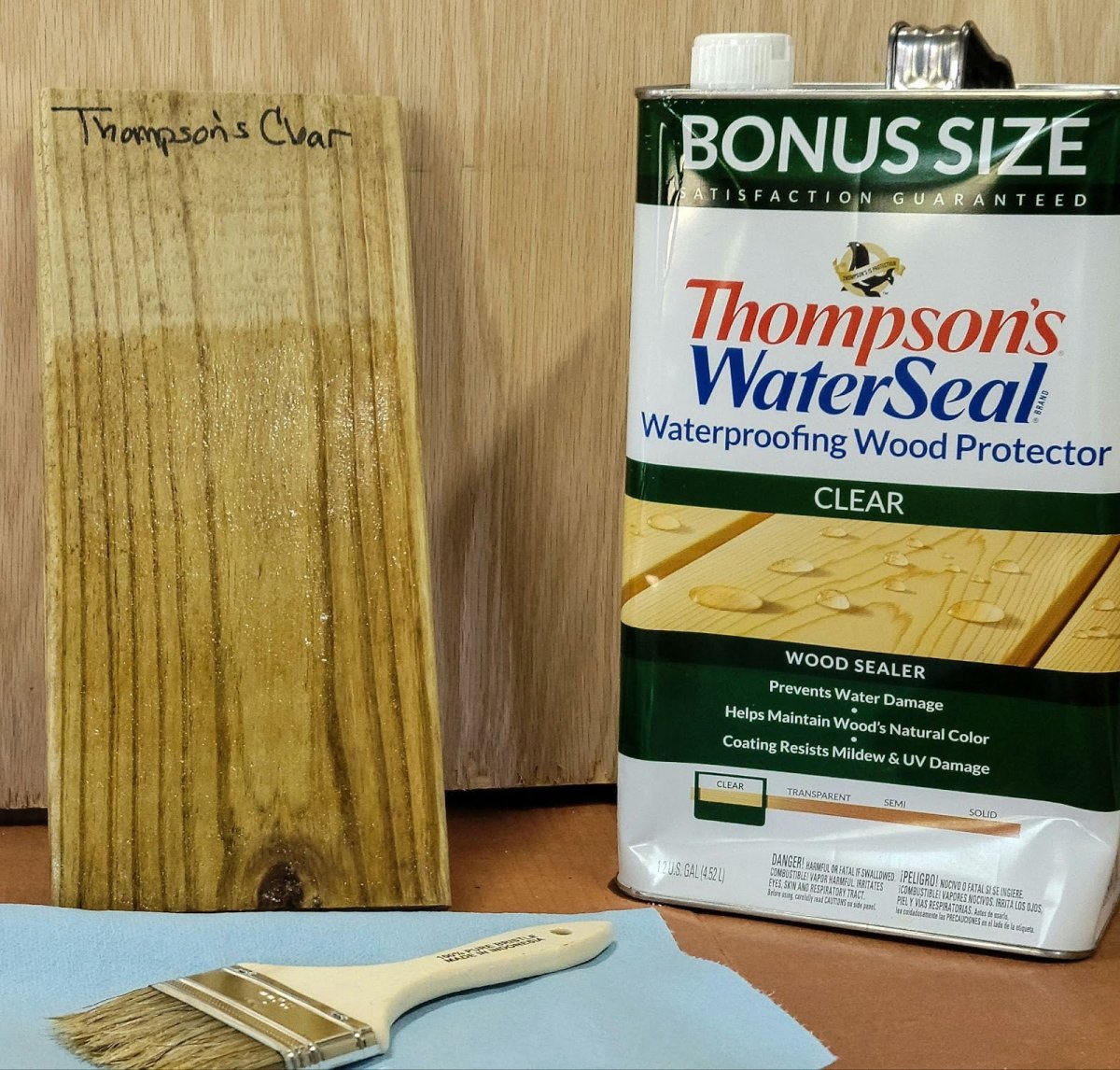
While some types of wood, such as cedar and redwood, naturally resist damage from water and insects, the most common material for new deck construction is pressure-treated wood. Treated wood is saturated with chemicals to help it resist moisture damage, but even this type of wood is not impervious to Mother Nature if unprotected. Pressure-treated wood will eventually begin to show signs of wear, such as warping and splintering, within a few short years if it’s not protected by the right sealer.
Some sealers, but not all, are suitable for use on composite decking (decking made from wood fibers and adhesives formed under pressure). Do not apply any sealer to a composite deck before checking to see if it’s compatible.
A quality deck sealer will create a water barrier on the wood to help extend the useful life of the deck. Before buying, users should consider the type of sealer best suited to their individual needs and the specific protection the deck requires.
Oil-Based vs. Water-Based
There are water-based and oil-based deck sealers on the market. Although water-based products are the more popular choice, both types have their pros and their cons.
- Ease of application: Oil-based sealers can be tricky to apply. If the deck isn’t completely dry when an oil-based sealer is applied, it’s likely to develop tiny bubbles or spots as the moisture tries to evaporate. Water-based sealers are safe to apply over slightly damp, though not wet, wood. Oil-based sealers are typically applied with a paintbrush, while water-based options can be brushed or sprayed onto the wood. Paint rollers aren’t common for applying deck sealer, regardless of the base.
- Environmental concerns: Water-based sealers emit fewer toxic fumes, making them less irritating to the eyes and lungs during application and better for the environment overall.
- Cleanup: Oil-based sealers require paint thinner or a similar solvent to clean brushes and tools after application, whereas water-based sealers wash off easily with just soap and water.
- Durability: Particularly if the weather is extreme, water-based sealers can flake or chip over time, which is rarely a problem with oil-based sealers.
- Preparation: When it’s time to reseal a deck, oil-based sealers are often more forgiving than their water-based counterparts. DIYers will still need to clean and prep the deck before applying either type of sealer, but oil-based products are generally a little easier to smooth on evenly over slightly rough wood or imperfections.
- Cost: Oil-based sealers are usually less expensive than water-based products, which can cost twice as much per gallon.
- Sheen: While water-based sealers rarely provide a finished sheen on the wood’s surface, oil-based sealers will often impart a slight sheen.
VOCs
Applying deck sealers, deck stains, or stain and sealer combo products, especially if they’re oil-based, can leave DIYers with headaches, burning eyes, or irritated nasal passages. This is due to fumes released by volatile organic chemicals (VOCs). In deck sealers, these VOCs are in the form of solvents designed to prevent sealer ingredients from separating and ensure a durable finish.
While no government regulations exist that specify the amount of VOCs permissible in deck sealers, manufacturers are constantly trying to reduce the amount of toxins while still producing quality products. The result is low-VOC and no-VOC sealers that emit fewer toxic fumes and are healthier for people and the environment.
- Low-VOC: Deck sealers labeled “low-VOC” contain less than 50 grams per liter (g/L) of VOCs. Compare that to some high-VOC sealers containing as much as 300 g/L.
- No-VOC: Sometimes labeled “zero-VOC,” these deck sealers contain very few—or no—VOCs. To qualify for the no-VOC label, products should contain less than 5 g/L.
Water and Mildew Resistance
If deck wood remains unsealed, moisture eventually leads to swelling, splitting, and rot. Unprotected decking boards are also prone to warping as they swell and contract with moisture variations. Deck sealer helps protect the wood from the damaging effects of moisture, including rain, snow, humidity, and sprinkler runoff.
Good deck sealers, like deck paints, may also include mildewcides, which are chemicals that kill fungal spores. In damp climates, the growth of mold or mildew on wooden decks can be frustrating because the white or black splotches are unsightly and difficult to eliminate. Those who live in a rainy or high-humidity climate should look for a sealer that fights fungus as well as moisture.
UV Protection
The sun’s ultraviolet (UV) rays can be merciless: Beating down day after day, they can damage the cell walls of all living things, including wood. That damage shows up on a wood deck as fading, cracking, and splintering. Deck sealers often provide UV protection thanks to added ingredients, such as tiny zinc particles that block harsh sun rays.
These ingredients tend to break down fairly quickly, however. This can occur even within a few months in a scorching and sunny climate. While deck sealers vary in durability, consider reapplying a simple water-based sealer each year before summer sets in to ensure optimal UV protection.
Coats
Many deck sealers require two coats for the best performance, though a few products can get the job done with just a single coat. That’s a big time-saver, although users will pay more for a single-coat sealer.
A water-based, penetrating sealer will often slightly raise the wood grain, which can lead to a rough surface feel. This happens when the moisture in the sealer causes the wood grain to swell and push upward. When the wood dries, the grain remains slightly higher in spots.
While some people may not mind the rougher texture, those who want a super-smooth finish can lightly sand the surface with 240-grit sandpaper before applying the second coat of sealer. Cure time varies by the product, so be sure to read the instructions. Some sealers require adding a second coat before the first coat is completely dry, while others recommend waiting a specified number of hours, typically 2 to 8 hours. No pressure is necessary—just lightly rub the sandpaper over the wood. Since the first coat seals the wood, the second coat will not raise the grain, resulting in a smooth deck surface.
Drying Time
Deck sealers vary in the amount of drying time they require. Many will dry to the touch within 1 to 5 hours, but humidity levels and outdoor temperatures can affect that time range.
- Water-based sealers: A coat of water-based sealer typically dries to the touch within 1 to 3 hours as long as the temperature is between 60 and 90 degrees Fahrenheit and the humidity is 50 percent or lower. Users can apply a second coat a few hours after the sealer is dry to the touch. Cure time (when the sealer has dried sufficiently for placing heavy furniture or walking) can be up to 24 hours.
- Oil-based sealers: An oil-based sealer usually dries to the touch within 4 to 12 hours, and users can apply a second coat in about 24 hours. Some newer oil-based sealers contain quick-dry additives that may shorten dry and recoat time. Cure time can be up to 72 hours.
Tips for Using Deck Sealer
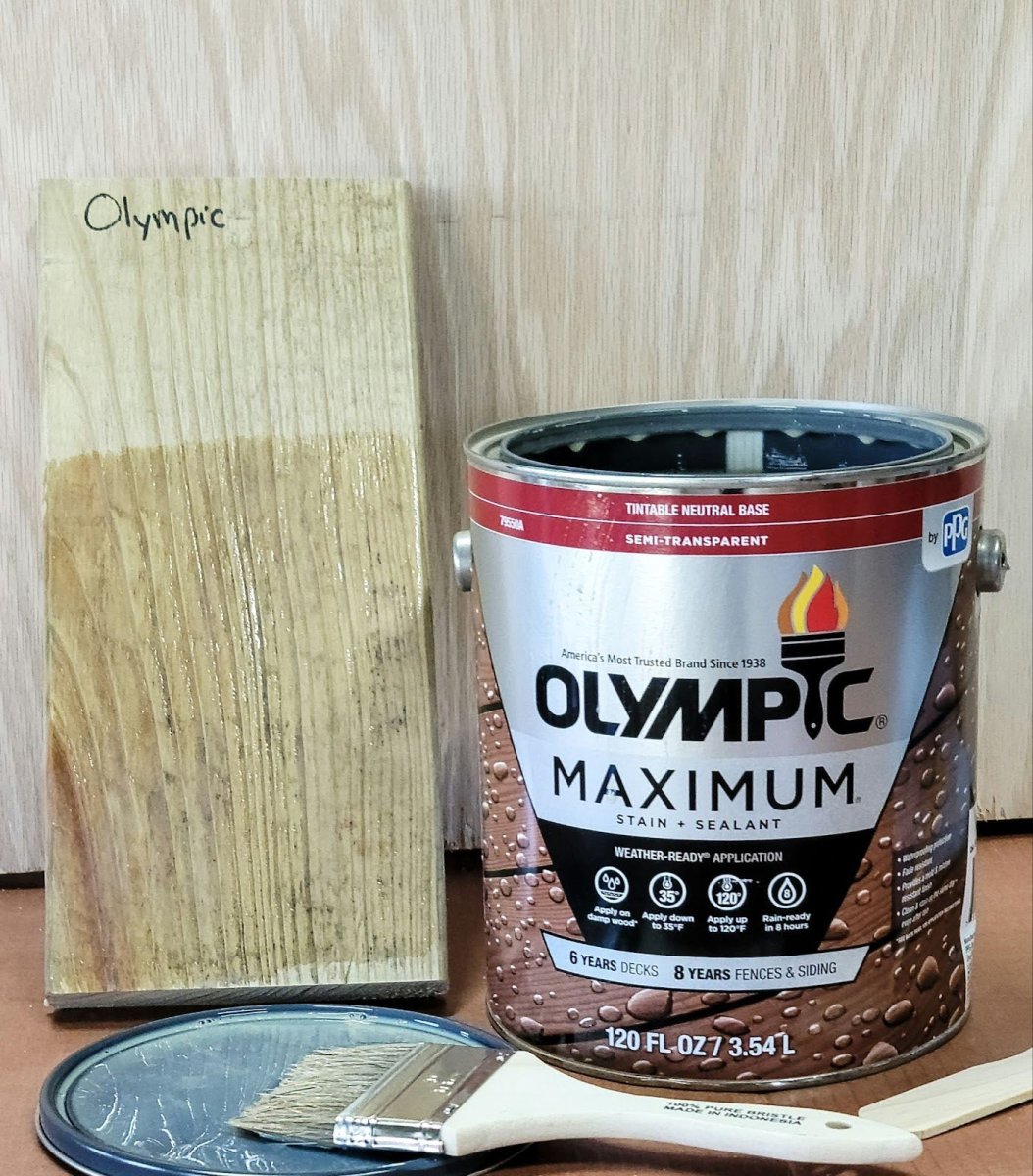
Applying a deck sealer is a relatively simple DIY project. In most cases, it doesn’t require a lot of time, although some prep work is necessary.
- Clean the deck with a deck cleaner designed to remove existing dirt, grease, and grime.
- Sand down rough spots, if necessary.
- Apply the sealer. Application can vary depending on the product, but most deck sealers require diluting with water and spraying with a pump-type sprayer or brushing it on with a paintbrush.
FAQs
Exterior wood is subject to weathering, so a deck won’t last forever. However, DIYers can prolong the useful life of a deck and maintain the natural beauty by protecting it with a deck sealer. For those hoping to keep a deck looking its best, a few questions are to be expected to ensure a job well done.
It depends on the type of wood. Weather-resistant woods, such as cedar or redwood, need only a clear penetrating sealer to protect them. Pressure-treated wood will benefit from a stain and sealer combo that gives it an attractive color while preserving the wood.
An oil-based deck sealer, such as Varathane Ultimate Spar Urethane Oil Based, will protect a deck for up to 5 years.
Thompson’s WaterSeal Clear Wood Sealer is one of the best options on this list for superior protection against water damage.
Meet the Tester
Glenda Taylor is a product tester and writer specializing in the construction, remodeling, and real estate industries. She and her husband own a general contracting company, and Taylor is experienced in both residential and commercial building applications. She tests a wide range of power tools as well as other home improvement, household, and lawn-and-garden products.

